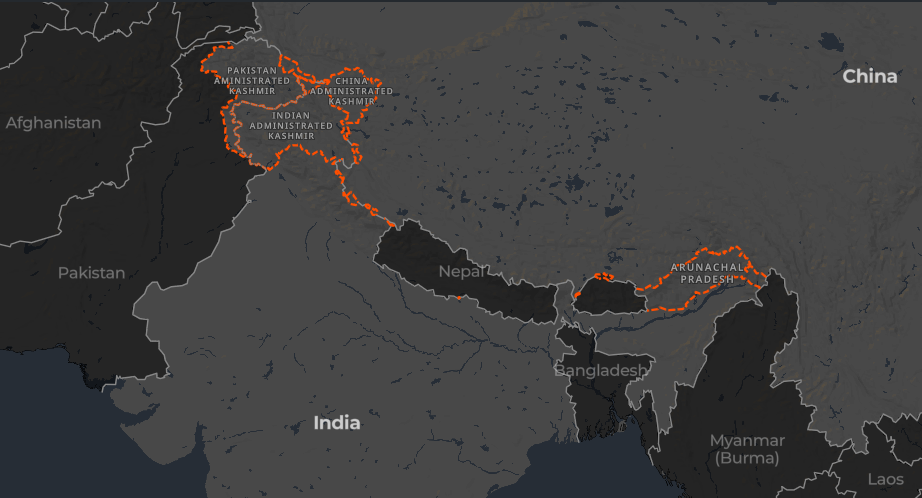On China’s Renaming Move

This topic of “On China’s Renaming Move” is important from the perspective of the UPSC IAS Examination, which falls under General Studies Portion.
Recent move by China:
- On December 29th, 2021, the Chinese Ministry of Civil Affairs announced that it is ‘standardizing’ the names of 15 places in Indian territory– specifically in Arunachal Pradesh.
- The Ministry said that this move is in accordance with the regulations on geographical names issued by State Council (the equivalent of Chinese Cabinet).
- This isn’t the first such instance. In April, 2017, China had issued ‘official names’ for 6 other places in Arunachal Pradesh. There were: “Wo’gyainling” (referring to Tawang), “Mila Ri” (Kra Daadi), “Qoidengarbo Ri” (West Siang), “Mainquka” (Siang), “Bumo La” (Anjaw) and “Namkapub Ri” (Subansiri).
Why is China renaming places in India?
- China has been claiming some 90,000 sq.km. area in Arunachal Pradesh as its own. It refers to the area as ‘Zangnan’ (in Chinese language).
- China has been making repeated references to ‘South Tibet’ and shows Arunachal Pradesh as part of its territory in its maps.
- It has made it a point to take efforts to periodically underline this unilateral claim to India’s north-eastern state. The current move to name the 15 places is a part of this effort.
Why is China claiming these territories?
- The McMahon Line is the boundary between British India and Tibet.
- It was agreed upon at the Simla Convention (‘Convention Between Great Britain, China, and Tibet’) in 1914.
- It is named after Henry McMahon, who was the chief negotiator from the British side at the Convention.
- It stretches from the eastern border of Bhutan to the Isu Razi Pass, which lies on the China-Myanmar border.
- China was represented at the Simla Convention by the Republic of China (declared in 1912, following the overthrow of the Qing Dynasty). The current communist government came to power in China, much later in 1949. This was when the People’s Republic of China (PRC) was proclaimed.
- Now, the PRC disputes the legal status of the McMahon Line. It is saying that it didn’t consent to the Convention and that Tibet doesn’t have independent authority to conclude international agreements.
- China is claiming territory south of the McMahon Line. According to China, its claims are based on historical ties between the monasteries in Lhasa (Tibet) and Tawang (AP).
- Renaming Indian territories is part of the strategy to assert China’s territorial claims.
- Whenever an Indian dignitary visits the north-eastern state, China issues statements expressing ‘outrage’- as it did recently, when the Vice President visited the state to address its Legislative Assembly in October.
- In 2017, the 1st batch of renamings came in the aftermath of Dalai Lama’s visit to Arunachal Pradesh. The visit provoked a strong protest from Beijing. However, China claimed that the ‘standardization’ move was necessary as all names used in the region (referred to as ‘South Tibet’) were inherited for generations via word-of-mouth by minority ethnic groups.
- Beijing holds that India’s possession of the north-eastern state, though internationally recognized and firmly established, is ‘illegal’. It has also been continuously asking New Delhi to cease ‘complicating the border issue’.
- Laying aggressive territorial claims based on alleged ‘historical injustices’ done to China is an element of Beijing’s foreign policy strategy. Arunachal Pradesh isn’t the only example. Other examples include the claims on Taiwan and the South China Sea islands.
What is the way ahead?
- India’s External Affairs Ministry has dismissed the recent move as ‘Chinese inventions’. The Ministry’s spokesperson reiterated that “Arunachal Pradesh has always been, and will always be, an integral part of India. Assigning invented names to places in Arunachal Pradesh does not alter this fact.”
- The recent renaming move, if largely symbolic, needs to be seen in the light of the broader changes in the Chinese approach to border questions.
- The re-naming announcement came ahead of January 1st, 2022– the day when the new Chinese border law comes into force.
- It calls for steps by Chinese government bodies to ‘safeguard’ its territories.
- This law was proposed in March 2021– a year into the border crisis along the LAC.
- India had expressed concerns about this law as it seems to be an attempt to formalize the Chinese military’s transgressions in the LAC area since the summer of 2020. It seems to be an attempt to give legal backing to China’s unilateral moves to redraw the LAC.
- China had responded that the latest move was ‘within its sovereignty’. This is in contrast to Beijing’s view on India’s reorganization of J&K in 2019. Beijing went as far as to raise the matter at the UNSC
- The recent move comes even as India and China continue to engage at various levels- diplomatic and military- to conclude the disengagement process at the LAC. 22 rounds of talks have been completed under the Special representatives dialogue framework.
- The countries have concluded a range of agreements to keep peace at the LAC. Some of them include:
- Special Representatives mechanism
- The Agreement on Political Parameters and Guiding Principles of 2005
- The WMCC (Working Mechanism for Consultation and Coordination on India-China Border Affairs)
- Protocols and CBMs
- Restoring status quo along the LAC and the bilateral relations require sensitivity on both sides and an adherence to agreements that have helped maintain the peace between the countries.
Conclusion:
Needless provocation is the last thing needed in a situation where two economic and military giants struggle to stick to diplomatic routes to resolve the crisis at the LAC and the larger border question.
Referred Sources

